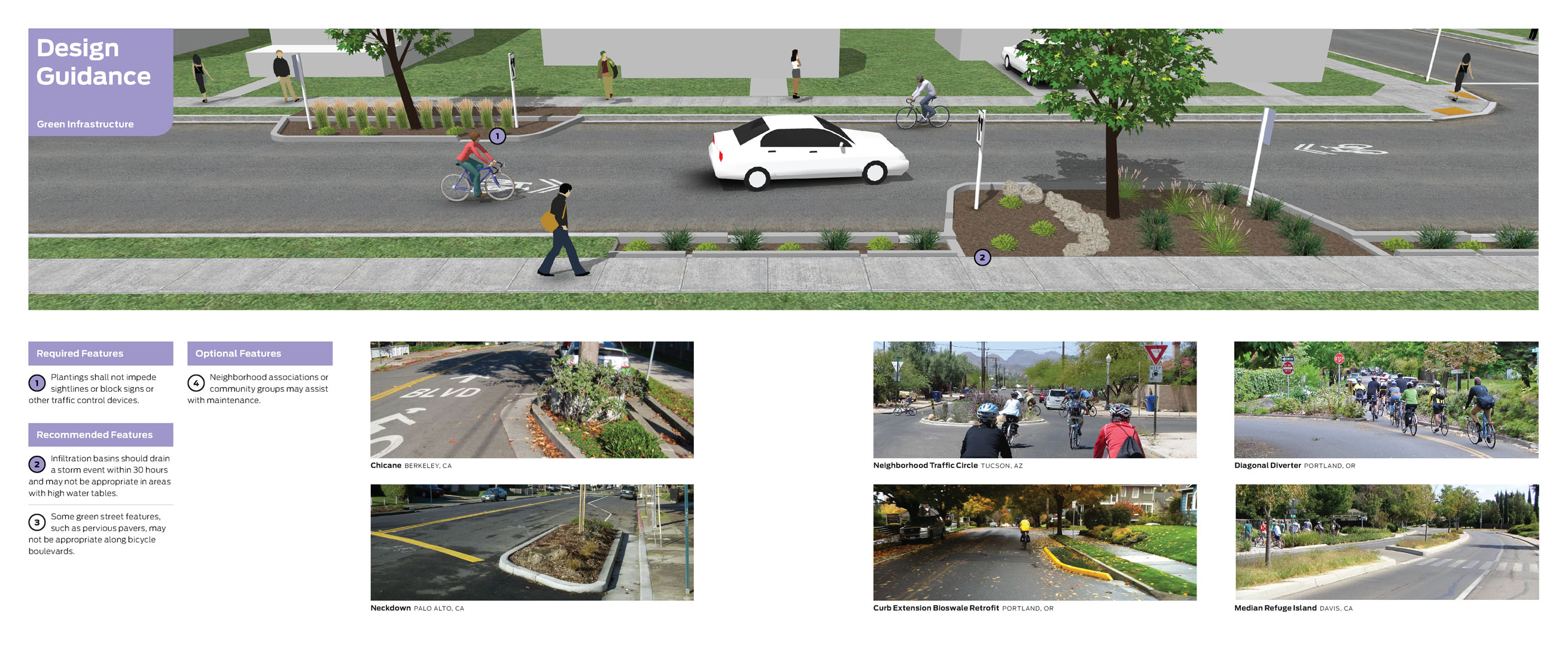Description
Green infrastructure is a planning and design approach to managing stormwater, the urban heat island effect, health,and air quality based on ecosystem network models. A green infrastructure approach is a shift from viewing systems as separate and disjointed components toward viewing systems as interconnected amenities that improve public health.
Bicycle boulevards present an opportunity to integrate stormwater treatment facilities, street trees, and publicgathering spaces with traffic speed and volume management treatments. By incorporating green street elements such asbioswales, infiltration basins, permeable pavement, plantings and street trees into curb extensions, pedestrian refuge islands, and chicanes, roadway runoff is slowly attenuated onsite, water quality is improved, paving is reduced, and habitat connectivity is improved.
Bioswales are gently sloping depressions planted with dense vegetation or grass that filters stormwater runoff as it flows through the swale, allowing it to slowly infiltrate into the ground. A vegetated infiltration basin or a rain garden is a landscaped depression that holds stormwater as it slowly infiltrates into the ground. Bioswales and rain gardens can be placed in curb extensions, islands, and chicanes to absorb and filter rain water, minimizing sewer runoff.
Green streets include treatments such as sidewalk widening, landscaping, and traffic calming to prioritize pedestrian and bicyclist travel. These improvements are ideal for bicycle boulevard corridors, due to the mutual benefits of speed and volume management and prioritizing nonmotorized transportation options. Read More+
The City of Seattle has piloted Street Edge Alternatives (SEA Streets) to reduce impervious surfaces, provide surface detention, and add plantings.
Treatment details can be accessed below under design guidance.
Benefits
- Provides an ecological and aesthetic enhancement of traditional traffic speed and volume control measures
- Provides a more pleasant environment for bicycling, walking or sitting.
- Improves drainage, reduces sewer costs, and minimizes the risk of basement flooding. Read More+
Facilities that filter stormwater through vegetation and soil have been shown to reduce total suspended solids (TSS) by 90%, organic pollutants/oils by 90%, and heavy metals by more than 90%.
United States Environmental Protection Agency. (1999). Storm Water Technology Fact Sheet: Bioretention.
- Improves street crossings because of reduced vehicle volume and speed and/or reduced crossing distance.
- Improves air quality, reduces the urban heat island effect, and can provide habitat connectivity by increasing urban green space.
- Reduces motor vehicle speeds along the corridor when used as curb extensions, edge islands, medians, and other speed management treatments.
- Reduces motor vehicle volumes along the corridor when used as diverters, closures, and other volume management treatments.
- Can use non-transportation funding sources, such as stormwater management or sewer treatment money, when needed improvements are prioritized along bicycle boulevards.
Typical Applications
- Place street trees and plantings in medians, chicanes, and other speed or volume management treatments.
- Develop bioswales and rain gardens in curb extensions and along planting strips.
Design Guidance

Click the image above to see the guidance summary page full screen.
| Required Features |
 |
Plantings shall not impede sightlines or block signs or other traffic control devices. |
| Recommended Features |
 |
Infiltration basins should drain a storm event within 30 hours and may not be appropriate in areas with high water tables. |
 |
Some green street features, such as pervious pavers, may not be appropriate along bicycle boulevards. |
| Optional Features |
 |
Neighborhood associations or community groups may assist with maintenance. |
Maintenance
- Inspect swales periodically, especially after major storm events.
- Remove sediment and trash, clean and repair inlets, curb cuts, check dams, and outlets as needed.
- Maintain side slopes to prevent erosion and provide proper drainage.
- Plants used in green street treatments should be selected to the local environment. Design should consider local conditions such as freezing, salt spray, flooding, and drought as well as pollutant and debris accumulation. Swales at the base of hills my incorporate a sediment collection area to reduce damage.